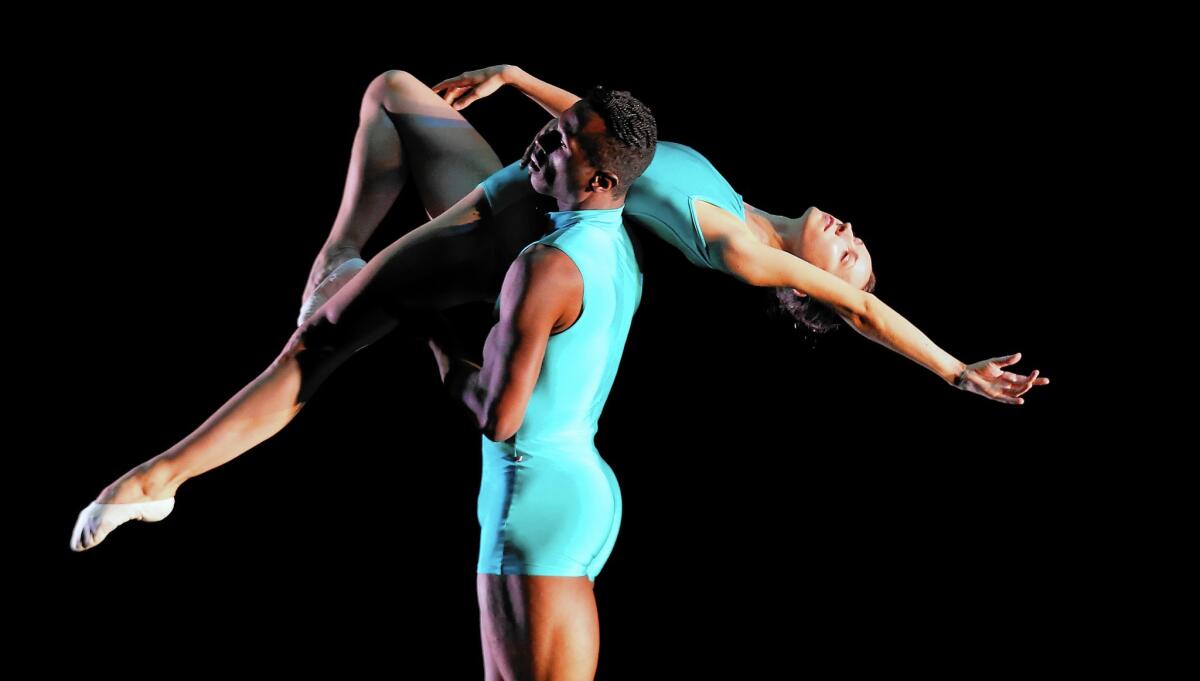Czech-U.S. Internet connection: Zbynek Mateju-Raiford Rogers’ ‘Still Life’

- Share via
Choreographer Raiford Rogers got the email last fall. It was from Prague. Zbynek Mateju, a prolific Czech composer who has created works for orchestras, opera, dance, film and television, said he would like to write a ballet score for Rogers.
The proposal got better. A Prague symphony would record Mateju’s composition for a Los Angeles performance by Raiford Rogers Modern Ballet. Oh, and after its premiere, the ballet would be performed at the National Theatre in Prague too. What did Rogers think?
He thought it was a joke. The veteran Los Angeles choreographer, whose abstract dances are a kinetic embodiment of the different music he loves, has a distinguished track record of collaborating with others, including visual artist John Nava, writer-performer Sandra Tsing Loh and composers Joey Altruda and Lloyd Rodgers.
ESSENTIAL ARTS & CULTURE NEWSLETTER >> Get great stories delivered to your inbox
Mateju, happily, wasn’t joking. After almost a year of communicating via email only, their new 24-minute piece, “Still Life,” will have its premiere Saturday at the Luckman Fine Arts Complex at Cal State Los Angeles. Rogers’ 2013 “Schubert’s Silence,” to which he is adding new material, is also on the program.
The two men have had a quintessentially 21st century working relationship. Mateju found Rogers on YouTube, where he watched samples from the choreographer’s repertory of more than 40 dances. They never spoke on the phone, and they met in person for the first time last week. Even before the first performance, both agreed this unusual partnership has worked.
Rogers gave Mateju free rein, with a caveat that also was something of a joke: to “write anything but a score for ballet.”
Mateju had been attracted to Rogers because of how the choreographer treats music.
“Raiford’s works are a great inspiration for me,” said Mateju, whose music has been performed throughout Europe, including a commission for Nederlands Dans Theater. “He is ‘very polite’ to music, very sensible. He can feel all what you put into the concrete composition.”
That’s not to say there haven’t been challenges.
“I was very nervous he would give me this big score a month before I started rehearsing,” Rogers said after a recent run-through at a Loyola Marymount University dance studio. The choreographer had asked the composer to send “little piano reductions, little five-minute clips” as he composed. “I’m glad he did because I heard the skeleton of the piece. I started to see the architecture of the music, even though it didn’t sound exactly like the finished work. I heard the spirit and the intent.”
Rogers began in his trademark method, literally sketching out the steps and phrases in drawings. He planned out the 24-minute ballet for 11 dancers over six months, beginning with the five-minute piano recordings. Rogers said he could hear Mateju on the recordings, occasionally yelling “strings” or “percussion,” tipping him off as to what instruments would dominate in different sections.
Even with months of work behind him, Rogers was initially stumped when the completed three movements arrived. The music was so rich and diverse in aural colors, beginning with bells and gongs, and sweeping from spare moments of stillness to great pounding layers of instruments. Rogers likened it to solving a Rubik’s Cube or a calculus problem. Always, his goal was to find the logic of a score — to articulate the arc of the music through movement but without doing the expected.
“That’s my whole thing is deciphering, decoding the music, and trying to stay away from the triumph of the obvious,” he said. “That’s what I’m trying to avoid. This was by far the greatest challenge ever for me. But I was very turned on by the complexity and the tremendous dynamic range.”
Zbynek even apologized for the dynamic shifts in the music, Rogers said. “Even he realized, how do you go from here to there?”
Rogers finally gathered dancers at end of June to teach them the ballet, which will be performed with a commissioned, shifting photographic backdrop by Ed Evans.
Rogers doesn’t hold auditions; dancers, many of them on break from other companies, are eager to work with him and to take part in his annual shows at the Luckman. Longtime soloist Bobby Briscoe flies in from Germany, and others have come from Virginia, Ohio and Northern California.
The Bohemia Ballet will perform “Still Life” at the Golden Prague festival on Sept. 30, but Rogers is hoping to bring a few of his dancers to supplement the cast.
Mateju said his composition ended up being a happy departure from his usual style because there were “no restrictions concerning style, timing.” Composer and choreographer were completely free, he said.
“ ‘Still Life’ can be also played live as a concert piece for cello with orchestra,” he said. “Like the ‘Rite of Spring’ by Stravinsky and a lot of other great compositions primarily scored for ballet.”
He and Rogers have already talked about a second collaboration, perhaps a full-length ballet.
“I’m feeling the response from the dancers,” Rogers said. “And Zbynek has played the music for some people, and the response has been really, really strong. I’m hoping this is the beginning of something.”
------------
‘Raiford Rogers Modern Ballet’
When: 8 p.m. Saturday
Where: Luckman Fine Arts Complex, Cal State Los Angeles, 5151 State University Drive, Los Angeles
Tickets: $15-$45
Info: Luckman box office at (323) 343-6600 or Ticketmaster at (800) 745-3000, ticketmaster.com
More to Read
The biggest entertainment stories
Get our big stories about Hollywood, film, television, music, arts, culture and more right in your inbox as soon as they publish.
You may occasionally receive promotional content from the Los Angeles Times.










